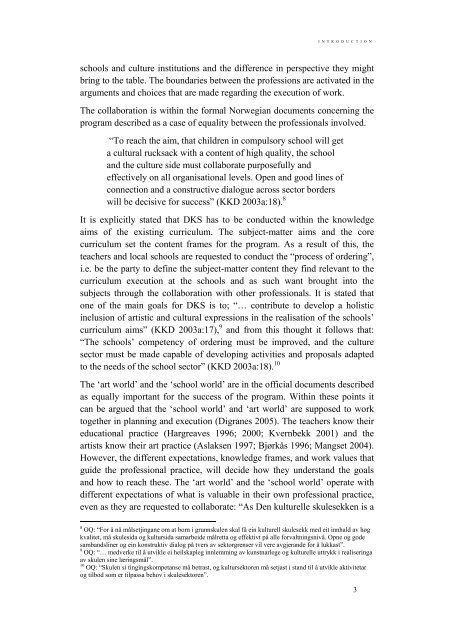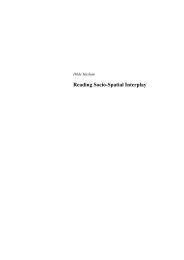CON ⢠TEXT - Arkitektur- og designhøgskolen i Oslo - AHO
CON ⢠TEXT - Arkitektur- og designhøgskolen i Oslo - AHO
CON ⢠TEXT - Arkitektur- og designhøgskolen i Oslo - AHO
- No tags were found...
You also want an ePaper? Increase the reach of your titles
YUMPU automatically turns print PDFs into web optimized ePapers that Google loves.
I N T R O D U C T I O Nschools and culture institutions and the difference in perspective they mightbring to the table. The boundaries between the professions are activated in thearguments and choices that are made regarding the execution of work.The collaboration is within the formal Norwegian documents concerning thepr<strong>og</strong>ram described as a case of equality between the professionals involved.“To reach the aim, that children in compulsory school will geta cultural rucksack with a content of high quality, the schooland the culture side must collaborate purposefully andeffectively on all organisational levels. Open and good lines ofconnection and a constructive dial<strong>og</strong>ue across sector borderswill be decisive for success” (KKD 2003a:18). 8It is explicitly stated that DKS has to be conducted within the knowledgeaims of the existing curriculum. The subject-matter aims and the corecurriculum set the content frames for the pr<strong>og</strong>ram. As a result of this, theteachers and local schools are requested to conduct the “process of ordering”,i.e. be the party to define the subject-matter content they find relevant to thecurriculum execution at the schools and as such want brought into thesubjects through the collaboration with other professionals. It is stated thatone of the main goals for DKS is to; “… contribute to develop a holisticinclusion of artistic and cultural expressions in the realisation of the schools’curriculum aims” (KKD 2003a:17), 9 and from this thought it follows that:“The schools’ competency of ordering must be improved, and the culturesector must be made capable of developing activities and proposals adaptedto the needs of the school sector” (KKD 2003a:18). 10The ‘art world’ and the ‘school world’ are in the official documents describedas equally important for the success of the pr<strong>og</strong>ram. Within these points itcan be argued that the ‘school world’ and ‘art world’ are supposed to workt<strong>og</strong>ether in planning and execution (Digranes 2005). The teachers know theireducational practice (Hargreaves 1996; 2000; Kvernbekk 2001) and theartists know their art practice (Aslaksen 1997; Bjørkås 1996; Mangset 2004).However, the different expectations, knowledge frames, and work values thatguide the professional practice, will decide how they understand the goalsand how to reach these. The ‘art world’ and the ‘school world’ operate withdifferent expectations of what is valuable in their own professional practice,even as they are requested to collaborate: “As Den kulturelle skulesekken is a8 OQ: “For å nå målsetjingane om at born i grunnskulen skal få ein kulturell skulesekk med eit innhald av høgkvalitet, må skulesida <strong>og</strong> kultursida samarbeide målretta <strong>og</strong> effektivt på alle forvaltningsnivå. Opne <strong>og</strong> godesambandsliner <strong>og</strong> ein konstruktiv dial<strong>og</strong> på tvers av sektorgrenser vil vere avgjerande for å lukkast”.9 OQ: “… medverke til å utvikle ei heilskapleg innlemming av kunstnarlege <strong>og</strong> kulturelle uttrykk i realiseringaav skulen sine læringsmål”.10 OQ: “Skulen si tingingskompetanse må betrast, <strong>og</strong> kultursektoren må setjast i stand til å utvikle aktivitetar<strong>og</strong> tilbod som er tilpassa behov i skulesektoren”.3
















